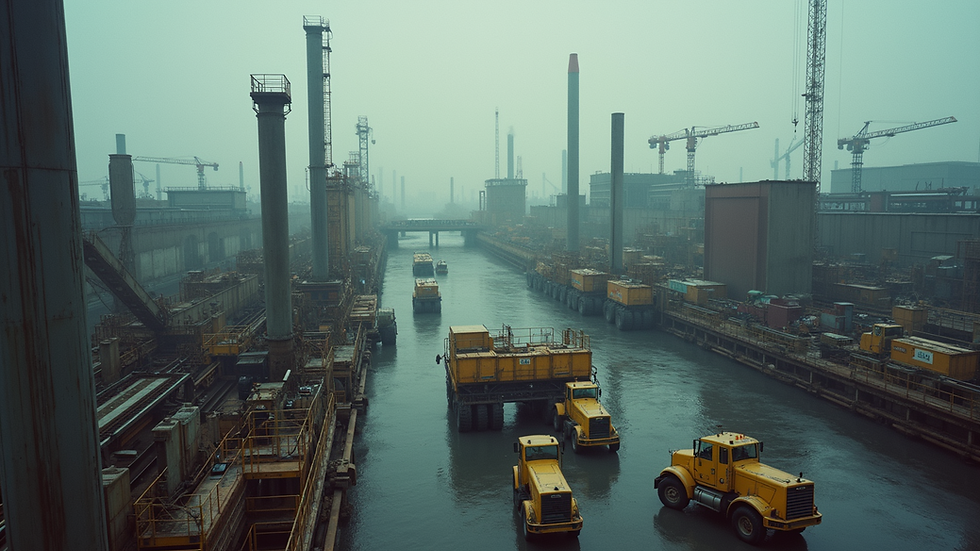Factory Feasibility Study
- tmiller813
- Mar 24
- 4 min read
When thinking about establishing a new factory, it is crucial to conduct a careful feasibility study.
This study acts as a roadmap for decision-making, guiding businesses in evaluating the practicality and potential success of their manufacturing projects.
A factory feasibility study examines various factors including financial implications, market conditions, technical needs, and potential environmental effects.
By assessing these areas, stakeholders can make smart decisions that reduce risks and boost profitability.
Significance of a Feasibility Study
A feasibility study is vitally important in the factory setup process.
It helps business owners identify possible challenges and opportunities before making significant financial commitments.
This analysis provides a structured method for planning and can be a convincing tool for gaining funding or investor support.
The study determines if the proposed factory can operate within budget and deliver expected profits.
According to a survey by the Project Management Institute, over 70% of projects succeed when a feasibility study is performed, underscoring its importance for sustainable growth and competitive edge in manufacturing.
Essential Components of a Factory Feasibility Study
A thorough factory feasibility study should encompass several key components to provide an all-encompassing analysis. Here are some of the most critical elements:
1. Market Analysis
Market analysis is vital for understanding demand for the products the factory will manufacture.
Conducting a deep examination of competitors, target demographics, and market trends helps clarify whether the market conditions justify opening the factory.
For instance, if research shows a 15% growth rate in demand for eco-friendly products over the next five years, it may be an opportune time to establish a factory focused on sustainable goods.
This section may involve surveys and competitor assessments to ensure alignment with customer needs.
2. Financial Projections
Financial projections outline expected costs, revenues, and potential profit margins.
This section typically reveals:
Startup Costs: Initial investments required for machinery, hiring, and raw materials.
Operating Costs: Recurring expenses related to factory operations.
Revenue Forecasting: Sales projections based on market insights.
A deep financial breakdown can help stakeholders visualize the financial landscape.
For example, if startup costs are estimated at $500,000 and the projected annual revenue is around $800,000, the return on investment can be clearly seen.
3. Technical Assessment
A technical assessment focuses on the necessary machinery, technology, and processes for production. It determines if the available infrastructure can support the proposed manufacturing operations or if new installations are required.
For example, if a factory plans to produce high-speed electronics, it must evaluate whether current technology can meet production goals and safety standards, ensuring efficient workflow.
4. Environmental Impact Study
Today’s manufacturing landscape demands careful attention to environmental issues. Assessing potential effects on air, water, and land is crucial for regulatory compliance and risk management.
For instance, a study may reveal that a proposed site is near a protected wetland, requiring specific filtration systems to minimize runoff. Addressing these environmental aspects not only aids in legal compliance but also enhances the company's image as a responsible community member.
5. Location Analysis
The factory's location significantly influences its success. Factors like proximity to suppliers, customers, transportation options, and workforce availability should be carefully considered.
A factory located within 50 miles of its major suppliers can cut logistics costs by nearly 30%. Thus, conducting a detailed location analysis is essential for optimal operational effectiveness.
6. Risk Analysis
Identifying potential risks is a key part of the feasibility study. This section examines both internal risks, like workforce challenges, and external risks, such as market unpredictability and regulatory shifts.
By analyzing potential obstacles, companies can develop strategies to mitigate these risks and enhance the chances of project success. For example, diversifying suppliers may reduce vulnerabilities related to material shortages.
Steps to Perform a Feasibility Study
Conducting a feasibility study requires several structured steps to ensure thoroughness. Below is a clear roadmap:
Define the Objective: Identify the goals of the feasibility study and what the company aims to accomplish.
Gather Data: Collect all relevant information for market analysis, financial forecasts, and technical needs.
Analyze Information: Evaluate the information to conclude about market viability, financial feasibility, and technical requirements.
Compile Findings: Document the results and provide recommendations based on the analysis.
Review and Revise: Have stakeholders review the report and adjust the findings based on their feedback. This ensures a well-rounded study.
Common Challenges in Conducting a Feasibility Study
Despite its importance, conducting a feasibility study can come with challenges. Here are some typical obstacles:
Limited Data Availability: Reliable market data may be hard to obtain, complicating the investigation.
Bias: Stakeholder opinions might distort the analysis, leading to inaccurate conclusions.
Resource Constraints: Restrictions in time and budget might compromise a thorough assessment.
Confronting these challenges demands a strategic mindset and a dedication to complete data collection and evaluation.
In Summary
A factory feasibility study is a crucial step when planning a new manufacturing operation.
It provides insights into market demand, financial viability, technical requirements, and environmental impacts.
By dedicating time and resources to this analysis, businesses can make informed choices that support sustainable growth and reduce risks.
In the competitive manufacturing landscape, understanding the feasibility of a factory project is essential for long-term success.
Companies planning new facilities would benefit from prioritizing a detailed feasibility study that lays the groundwork for their future endeavors.
Contact Us to discuss your Feasibility Study by calling, emailing or Book a Meeting to Zoom and Interview us.
Travis Miller
267 885 9333



Comments